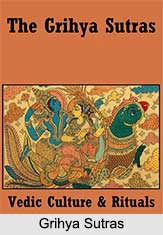 Grihya Sutras are one of the parts of Kalpa Sutras that deals with the domestic ceremonies and sacrifices of daily life. The Kalpa Sutras themselves arose out of the need to compile the rules for the sacrificial ritual in a shorter, more manageable and connected form for the practical purposes of the priests. Apart from the Grihya Sutras, the Kalpa Sutras comprises the Srauta sacrifices taught in the Brahmanas are called "Srauta Sutras". "Dharma Sutras", a scripture that forms the initial foundation of Hindu law, containing regulations regarding government, castes, relationships among people, economic actions, diet and religious affairs. Lastly, the Sulba Sutras that are the only sources of knowledge of Indian mathematics from the Vedic period.
Grihya Sutras are one of the parts of Kalpa Sutras that deals with the domestic ceremonies and sacrifices of daily life. The Kalpa Sutras themselves arose out of the need to compile the rules for the sacrificial ritual in a shorter, more manageable and connected form for the practical purposes of the priests. Apart from the Grihya Sutras, the Kalpa Sutras comprises the Srauta sacrifices taught in the Brahmanas are called "Srauta Sutras". "Dharma Sutras", a scripture that forms the initial foundation of Hindu law, containing regulations regarding government, castes, relationships among people, economic actions, diet and religious affairs. Lastly, the Sulba Sutras that are the only sources of knowledge of Indian mathematics from the Vedic period.
Content of Grihya Sutras
The contents of the Grihya Sutras are manifold and interesting. They contain directions for all usages, ceremonies and sacrifices by virtue of which the life of a person receives a higher sanctity. This "Samskara" is outlined for a person right from the moment when he is conceived in the womb, till the hour of his death and still further through the death-ceremonies and the cult of the soul. Thus, a large number of genuine popular customs and usages can be found in detail, which refer to conception, birth, the mother and the new-born child, the name-giving, the first outing and the first feeding of the child. There are exact directions for the shaving of the child"s head, the introduction of the pupil to the teacher which is known as "Upanayana", the mode of life of the "Brahmachari" and the dismissal of the pupil from the service of the teacher. The customs to be followed during the time of wooing, betrothal and marriage are presented in an especially detailed manner.
In the Grihya Sutras, the "five great sacrifices" already mentioned in the Shatapatha Brahmana, are minutely described. They are called "Great Sacrifices" because their performance is among the most important religious duties of every head of a household. These are the daily sacrifices to the Gods, demons and fathers. The simple evening and morning offerings, the new and full moon sacrifices, and the annual festivals connected with sacrifices are also presented in the Grihya Sutras.
In addition, such customs and ceremonies are also described as refers to house-building, cattle-breeding and farming, the rites to serve for averting diseases and unpropitious omens, as also exorcisms and rites for love magic etc. Finally the Grihya Sutras also deals with the funeral customs and the ancestral sacrifice known as "Shraadh". Later, it is assumed that they were soon treated with minute details in special texts named "Shraadh Kalpas".
Importance of Grihya Sutras
Grihya Sutras are valuable texts as they provide a great insight into the life of the ancient Indians. These are almost like the reports of eye-witnesses on the daily life of the ancient Indians, in the form of rules and precepts in these apparently insignificant Sutra texts. It is true that they describe the life of the ancient Indian father of the family only from the religious side, but as religion permeated the whole existence of the ancient Indians to such an extent that actually nothing could take place without an attendant religious ceremony. They are for the ethnologist most invaluable sources for the popular customs and usages of that ancient period. The numerous manners and customs with the usages described in the Grihya Sutras make the documents all the more important.




















